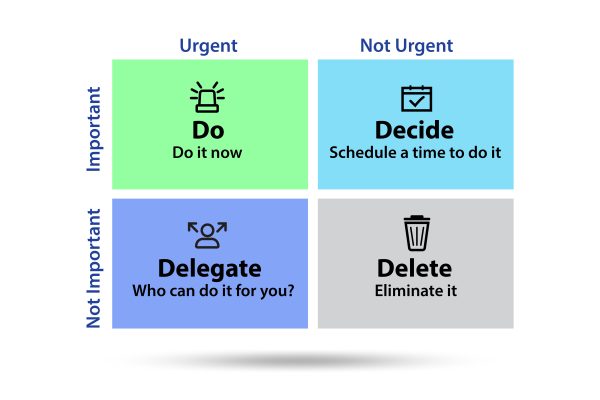
We humans struggle to switch from one thing to another efficiently. A problem compounded by the infinite number of dopamine-induced distractions we’ve become experts at finding. It’s no wonder context switching has such an impact on our ability to achieve the success and outcomes we desire. It’s also scary to think that the activities we typically switch away from are often the ones that can have the greatest impact.
What is context switching?
I put this basic question to ChatGPT, asking, ‘What is context switching?’ and it said:
Context switching is a computer operating system process that enables a computer processor to switch from executing one task to executing another task. When a computer’s operating system switches from one task to another, it needs to save the state of the currently executing task, including its registers, program counter, and other relevant information, so that it can later restore that state when the task is resumed.
Interesting, but not quite what I was looking for. Of course, when I asked what it meant for humans, the answer was more what I was thinking. For most of us mere mortals, our brains aren’t wired for multitasking like computer operating systems are. We can’t simply save an exact state to quickly return to when we’re ready. Our working memory can only hold a relatively small amount of information at one time, otherwise known as cognitive load.
Context switching in the human sense is when we switch between activities that require different modes of thinking. Like when you’re writing that important vision statement and receive a phone call − you need to switch your attention from writing to speaking and back again. Similarly, if you’re switching between different product initiatives, each with its own goals, needs, and deadlines, you switch your focus and mindset accordingly. Sound familiar?
Impacts of context switching
A mountain of evidence proves that each extra activity or ‘context’ we switch between negatively impacts our productivity by as much as 20%–80% of overall productivity. More specifically:
- Focusing on one task at a time = 100% of your productive time available
- Switching between two tasks = 40% productive time for each and 20% lost
- Switching between three tasks = 20% productive time for each and 40% lost!
Let’s be honest. The first question to ask yourself isn’t whether you’re suffering from the effects of context switching; it’s by how much. In product management, it’s almost impossible to avoid context switching completely, so the second question is how much is too much for us. Once we have our baseline for where we are today and the acceptable level we aspire to, we can start identifying preventative measures for our unique situation.
I’ve coached many product people and often observe product roadmaps (or an equivalent outlook if they don’t do roadmaps) that are tactically strong but need longer-term strategy and direction. Product people needing to manage their context switching more effectively greatly contribute to this. They let themselves get stuck in a feature factory with a product destined to resemble the Giant Swiss Army knife, which is not the ‘essential everyday carry’ it claims to be and is, at best, a jack of all trades and master of none.
Product management is about deeply understanding our customers and creating products and services which meet their needs while creating value for our organisation. We can’t do that effectively by switching from one browser tab, meeting, or conversation to another. There are many different things to think about in product management, from products to teams, outcomes, outputs, OKRs, KPIs, partners, stakeholders, etc.
Switching between multiple activities inevitably increases our stress levels. It also prevents us from genuinely understanding enough to make a difference.
Setting your baseline and target for improvement
Now that you understand what context switching is and its high-level impacts on your productivity, you should be motivated to know how much you suffer from it yourself. But where should you start? Don’t try to remember retrospectively when you may have switched between activities in the past. Start by tracking how often you switch from a planned activity to an unplanned one over the next few days or up to a week. Be honest with yourself, and don’t change your behaviour just because you’re tracking it! The output may begin to look something like this:
| Activity was doing | Switched to doing | Time spent | Date & time |
|---|---|---|---|
| Writing vision statement | Answered a phone call | 10 mins | 3 Mar 14:35 |
| Product discovery | Checking email | 5 mins | 3 Mar 15:50 |
| Checking email | Responding to email | 20 mins | 3 Mar 15:50 |
Armed with some honest and accurate data, you can set yourself a measured baseline of where you’re currently at. The baseline is the maximum number of times you switched from a planned activity to an unplanned one over a day. Remember to count all context switches, including when you did a double switch, like in the example above, by checking and responding to emails. For this oversimplified example, the baseline would be 3.
Most of us will have more extreme baselines than this and, therefore, more gains to make, but a good initial target for the example above would be getting down to 2. Be sure to measure yourself again regularly to see if you’re improving your baseline.
If you’re lucky enough to have a good manager or coach who regularly observes and understands your behaviour, you can ask them to help recognise and even call out areas where you’re switching from important and planned activities to less important unplanned ones.
While writing this post, my phone buzzed with a notification, and I looked at it!🤦
Positive impacts of reducing your context switching
Earlier, I mentioned the Giant Swiss Army knife. When I was a kid, I loved my (regular-sized) Swiss Army knife, but looking back, it was a toy rather than a useful tool for solving real problems in my day-to-day life. It wasn’t a good knife, it wasn’t a good saw, and I forgot the toothpick was even there, had I had a use for it. Successful product management requires the execution of a well-thought-out strategy. That strategy won’t write itself while you’re switching between numerous different contexts and fighting fires. But trust me; it will become easier to create if you focus time and energy on it, treating it with the importance it deserves.
Another positive impact is stronger relationships with your peers. They deserve your undivided attention but won’t get it if you dash from one activity to another. I recall when I was product manager across three different squads (aka product delivery teams). The craziness all came to a head for me one day when I walked into a team retro and started sharing my thoughts, only to be politely reminded by a fellow squad member that I was talking to the wrong squad! I was mortified and vowed never to put myself in a position where I let that happen again.
Other positive impacts include:
- Increased energy
- Increased creativity
- Improved quality of work
- Feeling less stressed
Preventative measures
If you’ve got this far, you must be motivated to start working towards a more energetic, creative, and productive way of working. As with most complex problems, everyone’s ideal solution will be different depending on their unique situation, but here are a few fairly basic preventative measures to think about:
- Eisenhower Matrix – for identifying important activities to plan ahead of time
- Blocking time – ensuring you can focus on one thing at a time
- Avoiding distractions
Eisenhower Matrix
If you don’t plan activities ahead of time, you’ll often miss opportunities to delegate to others better suited to carry them out. You may also miss opportunities to scrap activities altogether. I’ve found the Eisenhower Matrix a great framework to help with this. Just avoid putting everything in the urgent/important corner because, let’s face it, if you plan ahead and treat your priorities as important as other peoples’, most things should never get the chance to become urgent.
Blocking time
Switching from planned to unplanned activities is the most unhealthy type of context switching. By blocking out time for creative thinking, like assessing market opportunities, creating a product strategy, and writing objective customer interview questions, you’re giving yourself the best chance of getting into the flow needed to finish what you started with high quality. It can often take a few attempts on the same planned activity, but once you get going, it gets easier, and you’ll start to experience the benefits from this more focused and deliberate way of working. You have to be strict with your blocked-out time, though. Set up automatic declines for meetings scheduled at the same time and stick to that rule wherever possible.
Avoiding distractions
You need to turn unnecessary notifications and devices off to focus on planned activities. The simplest thing you can do is turn off notifications for emails, texts, Slack messages, and especially social media! Leaving the office and finding a quiet place outdoors with just a pencil and paper is an excellent way to get into a creative flow and avoid distractions.
Another suggestion I’ve heard works for some people is grouping similar activities (or topics) to reduce the switching between these different contexts. For example, say you need to refresh a product strategy for a particular product, and on the same day, you have a meeting with that product’s squad to refine some user stories. Try to schedule these two activities one after the other so the context switch is just tactical to strategic (or vice versa) and not a switch in the topic. A more advanced option could be to block out an entire day to focus on one or two topics or activities!
Think big, start small
We’re an ambitious bunch us product people. If you’re already thinking about setting aside 80% of your working time to think about just one activity or topic at a time, then you’re thinking big, and that’s great. But remember, good product management is about thinking big but starting small. Take that BHAG (Big Hairy Audacious Goal) and break it down so you can start and experiment with one or two relatively small things. Product Management 101 right there! That could be as simple as blocking out 2 hours of your working week for planned time on an important activity that is not necessarily urgent (yet!).
Conclusion
Most of us can benefit from and aspire to be more productive, but it takes time, like any behavioural shift, especially one as ingrained. People will often unknowingly try to disrupt your behavioural change, even more so if they don’t know you’re trying to change in the first place. So please don’t be shy; share your intentions with colleagues early on, bring them on the journey, and maybe even team up and do it together. The most important thing is to take ownership of your productivity because no one else can!
Bio
Tim Nunn has 18 years of product management experience for large global organisations and start-ups. He has focused on product leadership and consulting roles for the past five years, enabling him to coach product managers, product owners, and their teams. More recently, he has been getting involved in business transformation.





Leave a comment